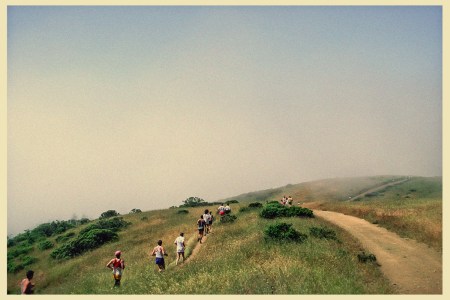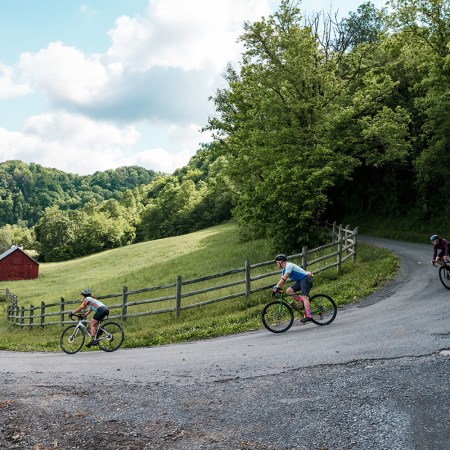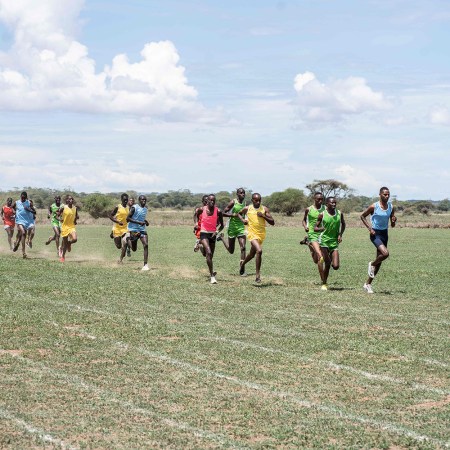It was somewhat of an odd year for Strava, the world’s leading fitness-tracking platform. On one hand, the app continued to capitalize on the red-hot endorphin economy, adding more activities and more members. As the company proudly reported in its Year in Sport Report, its 135 million users averaged a completed goal every 19 seconds in 2024. Strava’s engagement rate is abnormally good — leagues ahead of some of the biggest social media platforms, like Instagram and X — because its feeds have an agreed-upon purpose, and remain unpolluted by algorithmic content. Users follow their friends, in other words. A “kudos” still means something.
But Strava also found itself in the news (once again) for privacy concerns and data leaks. French newspaper Le Monde ran a shocking series detailing how the uploaded exercise routes of bodyguards revealed the private residences and operational travel patterns of world leaders including Joe Biden, Emmanuel Macron and Vladimir Putin.
Another investigation identified thousands of Israeli soldiers through their Strava profiles. This controversy harkened back to a national intelligence fiasco in 2018, when Strava’s global heatmap revealed the movements of American soldiers — and by extension, the precise locations of covert U.S. military bases in conflict zones like Afghanistan and Syria.
These breaches aren’t entirely Strava’s fault. Users have options to make activities visible only to selected followers or entirely private. For more robust protection, they can also designate certain “privacy zones” in order to mask sensitive start and end locations. The latter hides these details even from you, to make sure that if you later switch your profile to public or semi-public, or the data syncs to a third-party app, or there’s a data breach, that information remains protected. The feature offers peace of mind for an urbanite who doesn’t want the database to track their apartment address or daily meanderings. Yet it seems like an essential tool for military personnel or security detail, who, frankly, probably shouldn’t be using Strava at all.
Still, user error found a way, as it so often does, and Strava will be cleaning up the mess well into next year. One of its first measures? Limiting its collaboration with third-party apps. Strava will continue to sync with popular platforms like Garmin Connect, Zwift and Wahoo, but following a series of recent API changes, any app that relies heavily on Strava — displaying its interface, pulling its data for AI-generated workouts, etc. — will see their access diminished.
#MyDataNotStravas
I’ve had a Strava profile for five years, and have toggled it from public to private and back again, for various reasons. My Strava backlog is invaluable to me: I can easily view how I spent a day (or an hour, at least) years ago with a quick search; the app stores mapped routes of every three-miler I’ve ever taken on trips around the world; and if I ever wanted to run a marathon again, I could summon the exact, week-to-week programming I followed to run the New York City Marathon in 2023.
In recent weeks, meanwhile, the app’s paying subscribers have had access to a brand-new feature called “Athlete Intelligence (BETA),” which contextualizes the day’s effort based on mileage statistics, heart rate data and personal activity history. Sometimes, this summary is a little obvious, though you can see a pathway for the LLM to get smarter and smarter.
The flip side of this is: wow, do we give the platform a lot of information. Some online have called for boycotts of Strava (with the admittedly catchy rallying cry #MyDataNotStravas). Strava won’t lose my business anytime soon — I rely on the app too much, and besides, I think users can take necessary precautions to protect their data and privacy — but the company could clearly use some good press. To that end, there’s one initiative higher-ups should look to amplify in the new year: Strava Metro.
The Globetrotting Guidebook: Our Most Memorable Runs Across the Planet
A powerhouse panel of pro runners, legendary coaches and race directors share the routes they’ll never forgetWhat Is Strava Metro?
For years, Strava has shared its gargantuan dataset with urban planners, local governments and bike advocacy groups. The average marathoning Strava user probably hasn’t heard of Strava Metro (or just Metro, as it’s called internally) but your local trail stewards certainly have. And at a turbulent time for the company, the initiative is a bright calling card, a sign of what’s possible when all that information we keep giving Strava is used for good.
Metro celebrated its 10th anniversary last year. Tom Knights, the initiative’s marketing and partnerships lead, has worked on the project for the last six years.
“As a data enthusiast with a passion for maps and transportation, I knew I had to be part of it,” he says. “My professional background spans working with public- and private-sector clients on infrastructure projects worldwide, enhancing how we plan and navigate communities. I’m fascinated by how we move through our cities and love exploring the outdoors.”
According to Knights, Metro’s mission is to make “human-powered travel safe, accessible and efficient for everyone.” That’s theoretically the goal of large cities the world over: New York has pledged to cut its transport emissions in half by 2030, while London wants 80% of all journeys to be walked, cycled or completed via public transportation by 2041. Paris earned its flowers for doubling its bike ridership in a single year (and in its Olympics hosting year, no less).
But regulations and lawsuits so often slow these projects down. Even success stories, like Paris, have their share of complications. Decision-makers need as much data as possible to talk to local commuters, implement measures that make sense and anticipate potential issues. Fortunately, each one of those cities partners with Metro. And Metro played a direct role in Paris’s evolution over the last few years, collaborating with the city on route planning and design to accommodate the increase in visitors during the Olympics, which amounted to 3.1 million tourist arrivals in two weeks.
Oregon Makes a Deal
In 2013, the Oregon Department of Transportation approached Strava about purchasing its dataset in order to glean an understanding of movement trends throughout the state. At the time, ODOT was gathering the brunt of its cycling data through arcane means: employees would literally sit on the side of bike lanes and count cyclists as they zipped by.
This was back when Strava was primarily thought of as a “cycling app.” Margi Bradway, the active transportation head at ODOT at the time, was on a bike ride when she noticed everyone poking at the orange interface.
She struck a deal with Strava — a $20,000 annual fee for access to an infant version of Metro — and later on, representatives from the likes of London, Glasgow and Orlando followed suit. As Wired reported a decade ago, non-human cyclist-counters (robot cameras planted in the ground) cost $20,000 a pop, and could only monitor one spot. Striking a deal with Strava made much more sense.
Armed with their new information, departments were able to figure out where cyclists sped up or slowed down, when they rode on the sidewalk or stayed in the street. It made making infrastructure decisions easier (signs, lights, ramps, etc.) and the lives of recreational and commuting cyclists safer. Still, Metro had some growing up to do. Across the world, the data represented a tiny percentage of riders at the time (how many people did you know with Strava in 2014?), and while Strava was scrubbing personal information before it sold it off, it needed a more comprehensive privacy strategy in order to scale.
Taking care of the first issue: as the years passed, Strava got more and more popular. The app averaged 2.5 million rides and runs a week in 2014. In 2024, it averaged 40 million a week — and the app has a cyclical, compounding impact on communities that used its data to implement decision-making in the mid-2010s. Routes were made more accessible, which led to more people traveling by foot or bike, which lead to more Strava downloads and uploads, which led to more data…you get the idea.
Six years into these contracts, Strava was able to make Metro freely accessible to an expansive list of partner organizations, which Knights defines as “[those] dedicated to cycling and pedestrian experiences.” A sum of 3,500 organizations, including traffic planners, city leaders and park rangers have access to this data. Where are people moving? When are they doing it? Do existing routes make sense? Strava’s engineers populate a system called Metroview (here’s a demo version of it, for Denver County) with reams of inputs, minus private activities and accounts of members who’ve requested deletion.
According to Knights: “The data is aggregated and de-identified to comply with GDPR [General Data Protection Regulation] and CCPA [California Consumer Privacy Act] regulations. Additionally, Metro data cannot be used for commercial purposes, such as determining ad placements or optimizing cafe locations along routes.”
Global Case Studies
Maybe Metro can’t orchestrate perfectly positioned coffee shops, but it’s facilitated a variety of neighborhood improvements around the world.
It’s customary for advocates to invoke cities like Copenhagen and Amsterdam as the gold standard of bike friendliness — and sometimes to an extent where it seems like your city will never measure up. (The Netherlands: home of gorgeous underwater parking garages. We get it.) Knights points out that other European cities have closed the gap, though, especially Milan and Paris.
Aided with Metro insights, Paris launched “Plan Vélo 2021-2026,” which paved the way for over 100 miles of new bike lanes and over 100,000 new bicycle parking spots. And when tourists did arrive to the city this summer for the Olympics, they were able to travel from any city venue to another by bike (and actually rack it once arrived, thanks to temporary bike racks). Over in Milan, meanwhile, the “Cambio Biciplan” has invested hundreds of millions of euros to build a fascinating network — it sort of looks like a spiderweb — of radial lines and “ring roads.” The plan wants to make it easier to get around the city. Like, literally around it.
And to that last point: Metro doesn’t discriminate against exurbs or rural communities. These places are often under-governed, but as many of their constituents have Strava (some may even live in a sparsely populated area because they favor an outdoor/recreational lifestyle), the dataset can be leveraged to track visitor counts on country paths.
A ride shared on Strava in London not only helps [Transport for London] with its planning, it’s making your journey by bike or foot smoother and quicker.
– Tom Knights, marketing and partnerships lead for Strava Metro
This information isn’t just valuable for trail management. It can also be used to infer access and engagement to nature. In the U.K., the Department for Environment, Food & Rural Affairs (Defra) declared that British citizens should live within 15 minutes of a “green or blue space,” for mental health benefits and a sense of environmental stewardship. But in order to suss out the feasibility of that goal — and track its progress — it really helps to see if people are getting out into nature, and how easy (or not) those journeys are to make.
Transport for London (TfL) manages 1,000 roads across the capital, and its surface transportation team has been using Metro to model and program traffic signals to ensure more green time for cyclists and pedestrians. According to Knights: “A ride shared on Strava in London not only helps TfL with its planning, it’s making your journey by bike or foot smoother and quicker.” Elsewhere across the world, Metro has helped organizations realize some highly specific data: In Sydney, working with Transport for NSW, Metro determined a decline in ridership following Australia’s bushfires. In Brazil, the construction of viaducts increased ridership by 70% over a span of 18 months. If you build it, they will bike.
Coming to a Trail Near You
Metro has had an impact Stateside, too, of course, having first cut its teeth with Oregon all those years ago. Knights acknowledges that “Europe has certainly been more progressive in the past when it comes to bike and pedestrian infrastructure in towns and cities.” But the U.S., he says, is making strides. “What’s exciting about U.S. cities is there’s a desire for qualitative and quantitative data sources like Metro. [Groups want to] start a conversation about building better and safer routes for human-powered transportation.”
Knights points to Los Angeles as an American standout. Metro has worked extensively with the Los Angeles County Department of Parks and Recreation which oversees an expanse of parks, beaches, canyons and trails. “Metro data was instrumental in informing the 2022 Parks Needs Assessment Plus study,” he says, “which helped us to identify park access issues, examine and reimagine park restoration and conservation through an equity lens, and better understand regional and rural recreation needs.”
#MyDataNotStravas? Maybe. But the conclusion is pretty clear: when you share a ride, run or even walk to Strava, you’re empowering advocates with the facts and figures they need to make decisions, to lobby for money and make your community safer (at a time when pedestrian and cyclist deaths are ever on the rise).
In a recent essay for The New Yorker, the great George Saunders tried to solve our country’s tendency for knee-jerk polarization via an array of imagined scenarios, one of them being a group of Americans of different political persuasions sitting around a conference room and deciding which potholes in town deserve money for paving. He writes: “The discussion is not theoretical but practical…. This is problem-solving, something we Americans are good at (or at least think we are). Most people, of either party, know a pragmatic solution when they see one, especially if they’ve been working on the problem and have some idea of the costs, choices, and sacrifices required to solve it…. What may result among this group of people is something like fondness.”
I like that sentiment. Data-collecting companies are large, wonky and imperfect. Terrific scandals can happen, especially when high-profile users aren’t careful. But let’s not malign a decade of effort; Strava has used its figures for good. We should recognize that — and continue to rely on the company. There’s even a case study to match with Saunders’s example: thanks to Metro, the “speediest” sections of the Chuck Huckelberry Loop, a popular trail in Arizona, are prioritized for pavement preservation.
The Charge will help you move better, think clearer and stay in the game longer. Subscribe to our wellness newsletter today.



























